In this post I will explain 5 useful power supply failure indicator circuits which can be used to get an instant indication regarding an input power failure situation.
This post includes the following 5 types power failure indicator circuits:
- Using transistor, LED indicator without battery, for DC power supply.
- Using transistor, LED indicator and with battery, for DC power supply.
- Using transistor, buzzer alarm, for DC power supply.
- Using transistor, buzzer alarm, for AC 220 V power supply.
- Using op amp, LED indicator, for DC power supply.
Main Function
The main function of the proposed power failure indicator circuits is to alert or notify about a power failure situation in an electrical system.
The circuit can be used for indicating DC power supply failures or mains AC 220 v power failures, depending on the application needs.
The indication is provided through an LED, or a buzzer or both.
The circuit may use a battery backup for indicating to keep the LED illuminated for a much longer duration of time.
If a battery backup is not is used then a high value capacitor could be used for keeping the LED or the buzzer activated for brief period of time.
A battery backup allows the LED indicator to remain illuminated for much longer periods of time, until the input power is restored. This allows the user to view the indication and get notified anytime during a power failure.
Now, let's proceed with the circuit diagram explanations.
1) Using Transistor, LED, and without battery
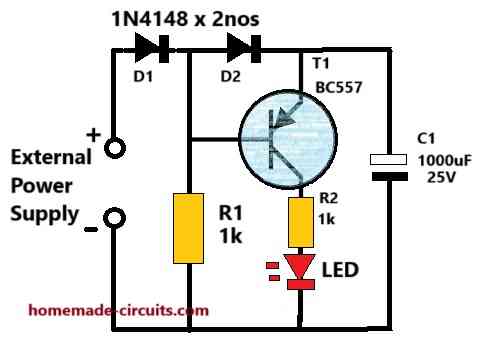
Parts List
- Resistor 1k 1/4 watt 5% = 2
- Capacitor 1000uF/25V = 1
- Diode 1N4148 = 2
- LED RED 20mA 5mm = 1
- Transistor BC557 = 1
The above diagram shows how a simplest DC power failure indicator circuit can be built using a single transistor and a few passive electronic parts.
Circuit Description
As long as the DC input supply is ON, the transistor is reverse biased through D1 diode.
In this situation, the transistor remains switched off causing the LED to be shut off.
In the meantime, the 1000uF capacitor stores the specified amount of charge in it through the external DC supply source.
Now, when the external DC power supply fails or is cut off, the transistor base gets forward biased and becomes switched ON. Due to this the LED also switches ON using the stored power in the 1000uF capacitor.
The LED remains illuminated until the charge inside the capacitor C1 is fully depleted.
2) Using Transistor, LED, and with battery
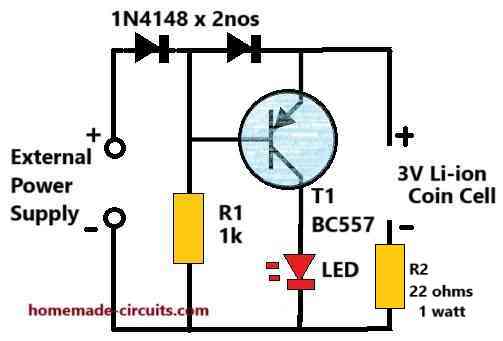
Parts List
- 1k 1/4 watt 5% = 1
- 22 ohms 1 watt 5% = 1
- Diode 1N4148 = 2
- Transistor BC557 = 1
- RED LED 20mA, 5mm = 1
- Battery 3V Coil Cell Li-ion = 1
Referring to the above circuit diagram, it works like a DC power supply failure indicator using a single transistor, LED and a battery backup.
The battery is a small li-ion 3 V cell.
The transistor can be any small signal PNP transistor such as a BC557.
The LED can be a 20 mA, 3V LED, preferably red in color.
Circuit Description
As long as the input DC power supply is available, the PNP transistor base remains reversed biased through the D1 diode.
Due to this the transistor T1 is unable to conduct and keeps the LED turned OFF.
As soon as the input DC power supply fails or cuts off, T1 base becomes forward biased through R1 and it instantly switches.
The battery supply is now able to pass through the LED and illuminate it.
The illuminated LED indicates the power failure situation.
Diode D2 ensures the 3V supply supply is prevented from reaching the base of the transistor.
The maximum input voltage must not exceed 12 VDC, otherwise the 3V cell might get damaged.
The 22 ohms resistor allows the li-ion cell to trickle charge as long as the input power supply is available.
If possible please add a 5V zener diode right across the 3V cell.
3) Using Transistor and Buzzer
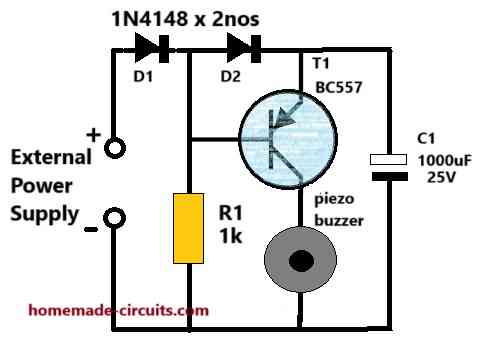
Parts List
- 1k 1/4 watt 5% = 1
- Diode 1N4148 = 2
- Transistor BC557 = 1
- Electrolytic Capacitor 1000uF/25V = 1
- Piezo Buzzer 3V = 1
In the above design we find that an automatic power failure indication is provided by a single transistor and a small piezo buzzer.
Circuit Description
The above power failure indicator circuit design is quite identical to the 1st design using LED and capacitor. Here, instead of the LED we use a piezo buzzer.
While the input DC is available, the transistor is reversed biased and switched OFF.
During this time the capacitor stores the DC power inside it.
The moment input power fails, the transistor becomes forward biased and turns ON the buzzer using the stored energy inside the capacitor.
The buzzer sounds for a brief moment of time until the capacitor power is fully used up.
An audible alert sound is more effective than an LED indication, since the audible sound quickly warns the user, even while the user is inattentive and busy some other work.
The piezo buzzer can be any small 3 V buzzer as shown in the following image.
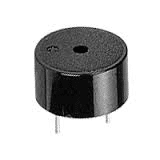
4) Using Transistor, Buzzer, for AC 220 V Supply
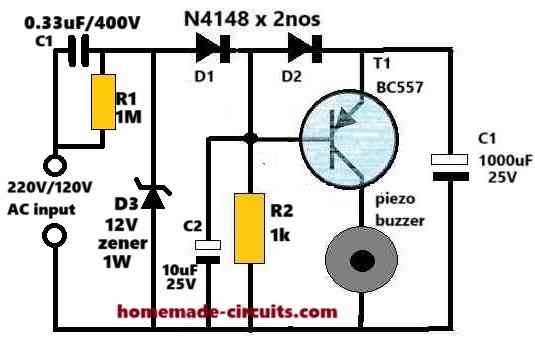
Parts List
- 1M 1/4 watt 5% = 1
- 1k 1/4 watt 5% = 1
- Electrolytic capacitor 10uF/25V = 1
- Electrolytic capacitor 1000uF/25V = 1
- PPC Capacitor 0.33uF/400V = 1
- Diode 1N4148 = 2
- Zener Diode = 12V/1watt = 1
- Piezo buzzer 3V = 1
WARNING: The above circuit is not isolated from mains AC and is therefore extremely dangerous to touch in open and uncovered position. Maintaining extreme caution is strictly advised.
If you require a power failure indicator which will indicate the AC mains power failure, then you can use the above shown circuit.
It includes a transformerless power supply circuit for stepping down the AC mains voltage to a suitable DC for the circuit. A buzzer and a 1000uF capacitor are used for the audible indication.
Circuit Description
Referring to the above circuit diagram, 0.22uF/400V capacitor along with its associated parts forms the mains AC 220 V step-down transformerless power supply circuit.
This stepped down DC from mains AC is applied to the base of the PNP transistor which keeps the transistor reverse biased.
As long as the mains power is available, the transistor remains switched off, keeping the buzzer silent.
In an event when the AC mains power fails, the PNP transistor quickly becomes forward biased and conductive causing the buzzer to switch ON. The buzzer now sounds using the stored energy inside the capacitor C1. The buzzer remains operative and buzzing so long until the capacitor C1 energy is fully depleted.
C2 and Z1 ensures a stabilized DC on the base of T1.
5) Using op amp, LED, and Battery
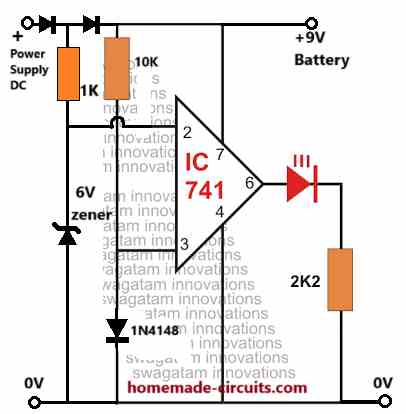
Parts List
- Resistor 1/4 watt 5% 1k = 1
- Resistor 1/4 watt 5% 10k = 1
- Resistor 1/4 watt 5% 2.2k = 1
- Diode 1N4148 = 1
- Zener diode 6V 1 watt = 1
- RED LED 20mA 5mm = 1
- IC 741 = 1
- Battery 9V PP3 = 1
NOTE: Please add a 1N4148 diode from the battery (+) side also otherwise the DC voltage from the power supply might damage the battery.
If you are looking for a power failure circuit using an op amp, then you can use the above shown configuration using an op amp.
Although the circuit is very accurate with its results, it appears to be an overkill compared the other transistor based designs.
Circuit Description
The circuit employs an IC 741 comparator, with its positive input (+) connected to a 1N4148 diode to establish a 0.6V reference voltage. The negative input (-) is coupled between two diodes, ensuring that it can only detect the external power supply DC and not the battery DC.
When the external power supply voltage on pin #2 of the IC exceeds the 0.6V potential at pin #3, the op-amp output remains at 0V, keeping the LED off.
If the external power DC on pin #2 drops below the 0.6V at pin #3, the op-amp output switches to the +9V battery level, illuminating the LED.
This concludes our article on simple power failure indicator circuits, if you have related questions, please feel free to post them through comment below.
Is there a way to get the buzzer alarm to sound in an intermittent (slow beeping) sort of way rather than a continuous tone?
I think small intermittent piezo buzzers are available ready-made online, you can try one of those and see how it works.
You can also make one but that can be bigger in size and consume more power.
I just ordered a few to try. I’d like to try and make a piezo driver. The type in this video looks like it uses a few transistors, resistors, and capacitor: youtu.be/n_qOsLfHdvw?si=kfPnUe6mnWoSPV7T&t=158 It would be interesting to reverse engineer perhaps.
The schematic diagram is not given in the video, so it actually doesn’t explain anything.
However, you can make a intermittent piezo driver using a 555 astable circuit.
I read your article “simplest piezo driver” and I can’t figure out how to integrate the 555 circuit into this one.
Actually a 555 is not required, you can use a single IC 4093 or any other quad NAND gate IC to create an intermittent buzzer circuit. An example circuit is discussed in the same article:
https://www.homemade-circuits.com/simplest-piezo-driver-circuit-explained/
I plan on making the 120v failure indicator circuit with two 3v Li-ion cells with 22 ohm 1W resistor in series in place of C1, The CD4011 driver circuit from the aforementioned article along with the buzzer, and changing C1 to 1uF/250v. It works well on breadboard, Is there anything I should be concerned about? Thank you for all the help.
The 22 ohm 1 watt may not be required which could otherwise make the charging process too slow for the batteries. For the 12V zener diode use a 3 watt zener since the 1uF/250V may generate significant switch ON in-rush current and might burn a 1 watt zener.
Thank you!
I tried the first circuit and it works fine, The 120v AC supply version does not seem to work.
Thank you for trying the circuits.
I have made the necessary corrections in the 120V version, please check it now, it should work now.
I tired it and now the buzzer is barely audible only when the 120v AC is applied.
Please try the following:
Remove the C2 10uF from the existing position and connect it parallel to the zener diode, if possible increase its value to 100uF/25V.
Also, try feeding an external 12V DC from the 1000uF capacitor side for further experimentation and troubleshooting.
The circuit is not isolated from mains AC so please beware and take necessary precautions while experimenting.
I found that simply increasing C2 to 100uF without moving it made it work perfectly! Thank you for the help!
OK, great! Thanks for updating the results.
I tried in with a different buzzer and it works but it still makes a trilling sound while the power is applied.
Hello, good afternoon, Mr. Swagatam. My name is Carlos. I’m looking for a simple circuit perhaps with 1 or 2 transistors and a Buzzer, what I want is for it to make a beep every 5 to 10 or more seconds. Can you help me? Thank you very much for your time.
Hi Carlos, Do you want the circuit to activate when power fails?
The circuit may be possible using the IC 555, but not with two transistor.
Hello Mr. Swagatam, thank you for your quick response. Only when he feeds does he start beeping. Thanks again
Carlos, sorry I did not understand what you mean by “Only when he feeds does he start beeping”
Hi.Interesting circuits, but could you have it with a memory? That is, what if the power goes out when I’m not there?
It can be done, however do you want the memory LED to be a separate LED or the same existing LED?
Thank you for your answer. With a separate led.
OK, no problem, you can try the following concept:
https://www.homemade-circuits.com/wp-content/uploads/2023/11/power-failure-indicator-circuit-with-memory.jpg